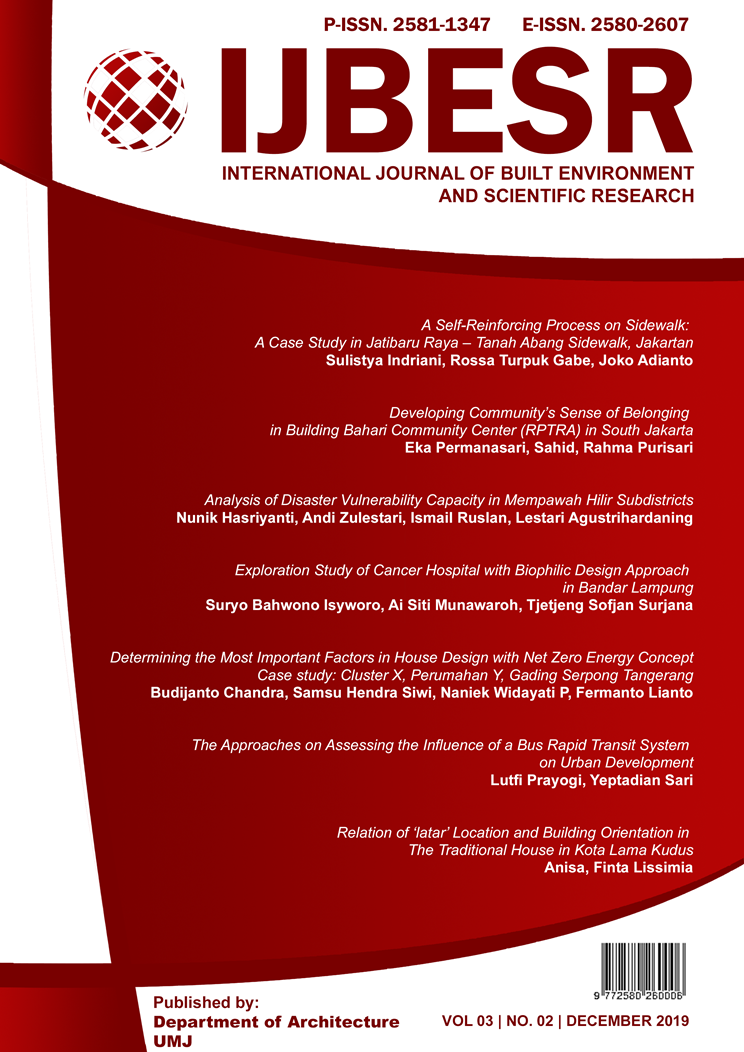Developing Community’s Sense of Belonging in Building Bahari Community Center (RPTRA) in South Jakarta
DOI:
https://doi.org/10.24853/ijbesr.3.2.63-70Keywords:
COMMUNITY CENTER, SENSE OF BELONGING, RPTRAAbstract
Capital city is full of layered memories from the authority in representing power and identity and from the everyday uses of place. Public space often represents and legitimates power. The use of top down approach in design is imminent and authority uses architecture and urban design as their means of showing identity. However, good urban design approach should include public participation in the process, allowing the users to take in charge and contribute to the decision making. A good city should be designed based on common good for all. The bottom-up approach uses the participative design method to allow citizen to speak, be heard and take in charge. It ensures the sustainable activity as community would be involved in using the place and preserving the resources. Everyone contributes to the city as citizen members of political community. As the result, community would have sense of belonging and engagement towards the public space. This research documented and analysis this participative design approach during the development of Jakarta community center (RPTRA) in South Gandaria. As one of the pilot projects, Bahari community center was one of the successful projects that included community participation during the design and implementation process. Through observation, interview and series of discussion, authors were engaged in this action research of implementing bottom up approach in designing public space.References
Statistik, B. P. Statistik Daerah Kecamatan Cilandak. Jakarta: BPS Kota Administrasi Jakarta Selatan; 2015.
Jones, P., Petrescu, D., & Till, J. Architecture and Participation. London and New York: Routledge; 2012.
Elyda, C., & Budiari, I. Jakartans Enthused with New RPTRA Community Centers. The Jakarta Post; September 2017.
Anderson, B. Imagined Communities: Reflections on the Origin and Spread of Nationalism. London: Verse; 1991.
Alsayyad, N. Forms of Dominance: On the Architecture and Urbanism of the Colonial Enterprise. Avebury: Aldershot; 1992.
Cowen, M., & Shenton, R. Doctrines of Development. London: Routledge; 1996.
De Certeau, M. Walking in the City. In S. During (Ed.), The Cultural Study Reader. London and New York: Routledge; 1993.
Lefebvre, H. Writing on Cities. Oxford: Blackwell Publisher; 1996.
Simmel, G. Sociology: Inquiries into the Construction of Social Forms. (translated by Blasi, A & Jacobs, A). USA: Brill; 2009.
Montgomery, C. Happy City. London: Penguin Books; 2013.
Arnstein, S. R. A Ladder of Citizen Participation. Journal of the American Planning association, 35(4); 1969, p. 216-224.
Friedman, J The good City: In defence of Utopian Thinking. In the Prospect Cities. Minneapolis: University of Minnesota Press. 2002. p.103-116.
Gehl, J. Life Between Buildings: using public space. Translated by J.Koch. 2011.







